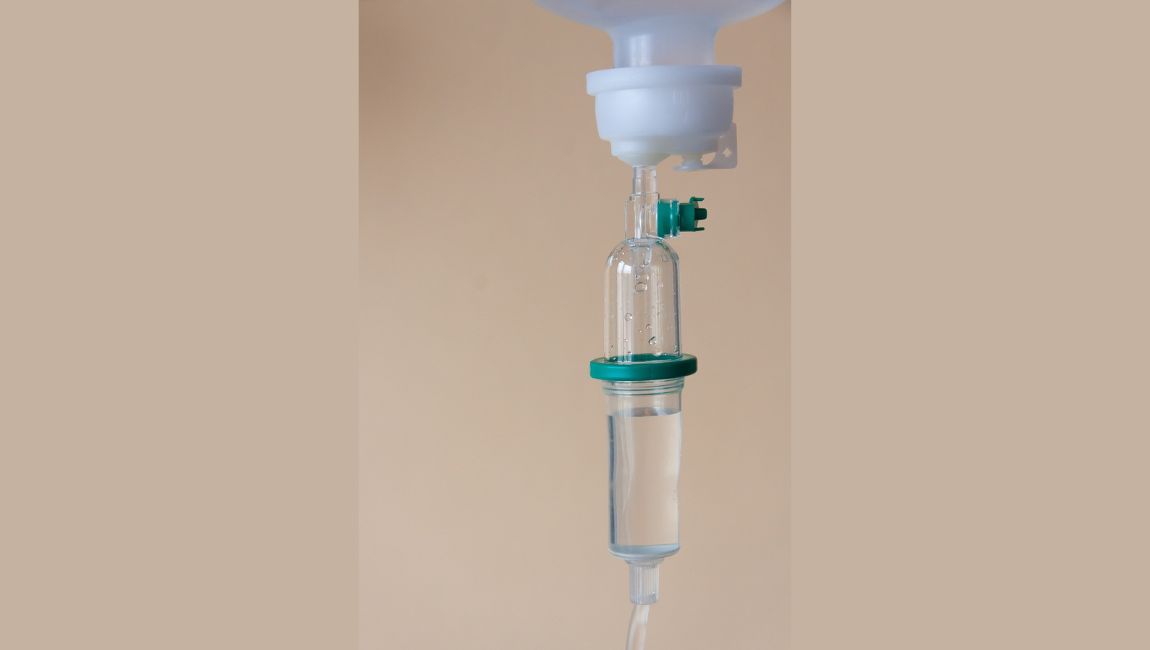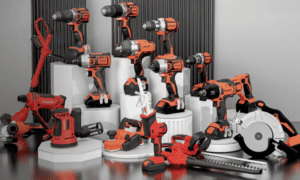Types of IV set based on applications
IV tubings are categorized based on their application, considering factors such as suitability for adults or children, compatibility with individuals allergic to natural rubber, the appropriateness of PVC-made infusion sets for specific medications, and the potential impact of UV exposure on drugs that may be sensitive to it, posing potential harmful effects.
Micro vs. Macro
Macro IV set& Micro IV set
Micro&Macro drip set
Micro drip set
As the name implies, the micro drip set has a device with a narrower tube diameter in the spike. Thus, smaller drops come out from the infusion set. Generally, the microbead produces 60 gtt/ml, implying that 60 drops of the liquid make up 1.0 mL. Hospital staff uses the micro drip when administration requires high precision, such as administering medications to infants and young children.
Macro drip set
IV set manufacturers design the macro drip set as a device with a wider tube diameter in the spike. There are three types of macro drips: 10 gtt/ml, 15 gtt/ml, and 20 gtt/ml, with ten gtt/ml producing ten drops per one mL of the solution. The higher the value of gtt/ml, the smaller the device’s diameter; the lower it is, the more significant the device’s diameter.
Medical staff uses the macro drip sets when precision is not of utmost concern. Hence, hospital staff uses them for routine IV administration.
Shop All Types of IV Set
Latex vs. Latex-free injection site
IV set with latex injection site
The injection site is the entry point for therapeutic medications and other substances the patient needs while having an IV infusion. The main types of injection sites are rubber bulbs and Y injection sites. Medical workers use the IV set with natural rubber for patients without a history of Latex allergy. Otherwise, they use the IV set with a silicone or isoprene injection site.
IV set withY site and rubber injection site
IV set with latex-free injection site
IV set manufacturers produce injection sites not made up of natural rubber to prevent the occurrences of latex allergy. Instead, they used isoprene or silicone as integral parts of the injection site. Medical staff uses them for patients with a history of latex allergy or patients who turn out to be allergic to it while being infused with IV fluid.
DEHP vs. DEHP-free
DEHP IV set
IV set manufacturers add bis(2-Ethylhexyl) phthalate, or DEHP, to the PVC-based IV sets to provide flexibility. However, DEHP fails to chemically react with the PVC to effect a strong chemical bonding. Hence, the DEHP molecules detached themselves from the IV set and found their way into the bloodstream of the patients, causing several health complications and side effects. Furthermore, the addition of DEHP causes the lowering of the concentration of any drug admixed to the infusion solution through the process of adsorption.
DEHP-free IV set
Hospital workers use IV sets without DEHP to avoid its health complications and its tendency to reduce the concentration of any drug admixed in the infusion solution.
Lightproof vs. Regular
Lightproof IV set
IV set manufacturers designed lightproof IV sets to protect light-sensitive drugs from UV exposure, which could cause harmful effects. The lightproof IV set, also known as a light-resistant IV set, reduces the adverse effects of UV light on various drugs in oncology and infectious diseases, such as antibiotics. Specifically, UV light is instrumental in the decomposition of the active ingredients of different medications. Thus, hospital workers resort to using lightproof IV sets to preserve the potency of light-sensitive drugs.
Lightproof IV set
Lightproof IV set
Regular (Not Lightproof) IV set
In the case of the standard IV sets, IV set manufacturers do not equip them with materials to shield drugs from the decomposing effects of UV light. Thus, hospital workers use them to infuse solutions without any light-sensitive drugs. They use it for the routine IV infusion of fluid.
Types of IV set based on functions
IV tubings can be categorized by their functions, including considerations such as compatibility with hard glass containers or collapsible plastic liquid, the necessity of a solution filter for screening small micros and contaminants, the choice between a luer lock connector for a secure bond or a luer slip connector for easy installation and removal, and the use of an auto air stop filter to prevent air entry into the fluid line even when the intravenous bottle is empty.
Vented vs. Non-vented
vented&non vented iv set
Vented&Non-vented iv set
Vented IV set
IV set manufacturers equip IV sets with air vents to allow air entry into the liquid container. Physicians and other health workers use vented IV sets when using hard plastic or glass containers. Hospital staff opens this vent to allow air entry as the fluid leaves the solution container or closes it when not in use. IV fluid from a rigid container does not flow when using non-vented IV sets.
Air vent & solution filter
Non-vented IV set
Non-vented IV sets lack air vents. Thus, they work well when using collapsible plastic liquid containers because non-vented tubing creates a vacuum within the plastic IV bag as the liquid leaves the container. In addition, medical workers need to prime the non-vented tubing to eliminate air entrapped in the tubing.
With solution filter vs. Without solution filter
With solution filter
IV sets with solution filters possess a small micron filtrating structure inside of them. This filter removes possible contaminants, such as particulates, bacteria, or air emboli, admixed in the IV solution. Thus, the solution filter protects the recipient patient from receiving harmful materials that could cause phlebitis and other infections.
Hospital staff uses the filtered IV sets when infusing a wide variety of medications admixed in the IV solution, and they use different sizes of filters depending on the intended use. 0.22 or 0.5-micron filters can be used to filter out bacteria and particles.
Without solution filter
IV sets manufacturers also produce IV sets without filters. Hospital workers use them for less sensitive medical situations.
Shop All Types of IV Tubing
Luer lock vs. Luer slip
Luer lock IV set
The Luer lock IV set uses a specialized part called the Luer lock connector. IV set manufacturers designed them to connect the needles to the IV tubes. Thus, they securely connect the male-taper fitting and the female mating parts, ensuring the connection is leak-free. In addition, screwing the needle onto the Luer lock connector establishes a tight bond that prevents the cannula from accidentally detaching from the tube.
Luer lock IV set
Luer slip IV set
The Luer slip IV drip set has a friction-fit end, allowing the needle to be “slipped” or pushed into the tubing hub, resulting in a relatively secure connection. Hospital workers use this type of IV set for short-duration IV fluid administration with or without medications.
Luer slip IV set
Auto air stop vs. Regular
Auto air stop IV set
An auto air stop IV set is an IV tubing set with an auto air stop filter. IV set manufacturers specially engineered the Auto Air Stop Filter (15 microns) to prevent air entry into the fluid line even if the intravenous bottle has run out of its content. For this reason, it prevents air bubbles from entering the patient’s venous system via the infusion line. This distinct mechanism arises from the ability of the auto air stop filter to maintain a constant fluid level. Aside from preventing air embolism, it also screens out particulates that could harm the patient.
Regular IV set (without auto air stop filter)
Hospital staff uses IV sets without auto stop mechanism for short-duration IV infusion and in hospital settings where nurses and other hospital staff could spend more time supervising the work.
Contact Us For More Information
Company Introduction
Liaoning KANGYI Medical Equipment Co., Ltd was founded in 1994 and is one of the leading manufacturers of IV sets, syringes, and medical parts in China. Quality is our highest priority, and our quality assurance system is certified and meets the standards of the Chinese National Medical Products Administration, ISO 13485, and the European Union’s CE mark.
We produce over 600 million pieces per year. Our products are sold across China and exported worldwide, to destinations including Europe, South America, Russia, Africa, and the Middle East.
Our company employs over 300 staff, including 50 people working in engineering and technical management. Our premises occupy an area of 20,000 square meters, with a construction area of 15,000 square meters. This space includes a 100,000-class purification workshop that occupies 8,000 square meters.
If you want to know more about us and talk face to face, we welcome you to visit our booth in CMEF Shanghai and Hospitalar in Brazil.Types of IV set based on applications
IV tubings are categorized based on their application, considering factors such as suitability for adults or children, compatibility with individuals allergic to natural rubber, the appropriateness of PVC-made infusion sets for specific medications, and the potential impact of UV exposure on drugs that may be sensitive to it, posing potential harmful effects.
Micro vs. Macro
Micro&Macro drip set
Micro drip set
As the name implies, the micro drip set has a device with a narrower tube diameter in the spike. Thus, smaller drops come out from the infusion set. Generally, the microbead produces 60 gtt/ml, implying that 60 drops of the liquid make up 1.0 mL. Hospital staff uses the micro drip when administration requires high precision, such as administering medications to infants and young children.
Macro drip set
IV set manufacturers design the macro drip set as a device with a wider tube diameter in the spike. There are three types of macro drips: 10 gtt/ml, 15 gtt/ml, and 20 gtt/ml, with ten gtt/ml producing ten drops per one mL of the solution. The higher the value of gtt/ml, the smaller the device’s diameter; the lower it is, the more significant the device’s diameter.
Medical staff uses the macro drip sets when precision is not of utmost concern. Hence, hospital staff uses them for routine IV administration.
Shop All Types of IV Set
Latex vs. Latex-free injection site
IV set with latex injection site
The injection site is the entry point for therapeutic medications and other substances the patient needs while having an IV infusion. The main types of injection sites are rubber bulbs and Y injection sites. Medical workers use the IV set with natural rubber for patients without a history of Latex allergy. Otherwise, they use the IV set with a silicone or isoprene injection site.
IV set withY site and rubber injection site
IV set with latex-free injection site
IV set manufacturers produce injection sites not made up of natural rubber to prevent the occurrences of latex allergy. Instead, they used isoprene or silicone as integral parts of the injection site. Medical staff uses them for patients with a history of latex allergy or patients who turn out to be allergic to it while being infused with IV fluid.
DEHP vs. DEHP-free
DEHP IV set
IV set manufacturers add bis(2-Ethylhexyl) phthalate, or DEHP, to the PVC-based IV sets to provide flexibility. However, DEHP fails to chemically react with the PVC to effect a strong chemical bonding. Hence, the DEHP molecules detached themselves from the IV set and found their way into the bloodstream of the patients, causing several health complications and side effects. Furthermore, the addition of DEHP causes the lowering of the concentration of any drug admixed to the infusion solution through the process of adsorption.
DEHP-free IV set
Hospital workers use IV sets without DEHP to avoid its health complications and its tendency to reduce the concentration of any drug admixed in the infusion solution.
Lightproof vs. Regular
Lightproof IV set
IV set manufacturers designed lightproof IV sets to protect light-sensitive drugs from UV exposure, which could cause harmful effects. The lightproof IV set, also known as a light-resistant IV set, reduces the adverse effects of UV light on various drugs in oncology and infectious diseases, such as antibiotics. Specifically, UV light is instrumental in the decomposition of the active ingredients of different medications. Thus, hospital workers resort to using lightproof IV sets to preserve the potency of light-sensitive drugs.
Lightproof IV set
Regular (Not Lightproof) IV set
In the case of the standard IV sets, IV set manufacturers do not equip them with materials to shield drugs from the decomposing effects of UV light. Thus, hospital workers use them to infuse solutions without any light-sensitive drugs. They use it for the routine IV infusion of fluid.
Types of IV set based on functions
IV tubings can be categorized by their functions, including considerations such as compatibility with hard glass containers or collapsible plastic liquid, the necessity of a solution filter for screening small micros and contaminants, the choice between a luer lock connector for a secure bond or a luer slip connector for easy installation and removal, and the use of an auto air stop filter to prevent air entry into the fluid line even when the intravenous bottle is empty.
Vented vs. Non-vented
Vented&Non-vented iv set
Vented IV set
IV set manufacturers equip IV sets with air vents to allow air entry into the liquid container. Physicians and other health workers use vented IV sets when using hard plastic or glass containers. Hospital staff opens this vent to allow air entry as the fluid leaves the solution container or closes it when not in use. IV fluid from a rigid container does not flow when using non-vented IV sets.
Air vent & solution filter
Non-vented IV set
Non-vented IV sets lack air vents. Thus, they work well when using collapsible plastic liquid containers because non-vented tubing creates a vacuum within the plastic IV bag as the liquid leaves the container. In addition, medical workers need to prime the non-vented tubing to eliminate air entrapped in the tubing.
With solution filter vs. Without solution filter
With solution filter
IV sets with solution filters possess a small micron filtrating structure inside of them. This filter removes possible contaminants, such as particulates, bacteria, or air emboli, admixed in the IV solution. Thus, the solution filter protects the recipient patient from receiving harmful materials that could cause phlebitis and other infections.
Hospital staff uses the filtered IV sets when infusing a wide variety of medications admixed in the IV solution, and they use different sizes of filters depending on the intended use. 0.22 or 0.5-micron filters can be used to filter out bacteria and particles.
Without solution filter
IV sets manufacturers also produce IV sets without filters. Hospital workers use them for less sensitive medical situations.
Shop All Types of IV Tubing
Luer lock vs. Luer slip
Luer lock IV set
The Luer lock IV set uses a specialized part called the Luer lock connector. IV set manufacturers designed them to connect the needles to the IV tubes. Thus, they securely connect the male-taper fitting and the female mating parts, ensuring the connection is leak-free. In addition, screwing the needle onto the Luer lock connector establishes a tight bond that prevents the cannula from accidentally detaching from the tube.
Luer lock IV set
Luer slip IV set
The Luer slip IV drip set has a friction-fit end, allowing the needle to be “slipped” or pushed into the tubing hub, resulting in a relatively secure connection. Hospital workers use this type of IV set for short-duration IV fluid administration with or without medications.
Luer slip IV set
Auto air stop vs. Regular
Auto air stop IV set
An auto air stop IV set is an IV tubing set with an auto air stop filter. IV set manufacturers specially engineered the Auto Air Stop Filter (15 microns) to prevent air entry into the fluid line even if the intravenous bottle has run out of its content. For this reason, it prevents air bubbles from entering the patient’s venous system via the infusion line. This distinct mechanism arises from the ability of the auto air stop filter to maintain a constant fluid level. Aside from preventing air embolism, it also screens out particulates that could harm the patient.
Regular IV set (without auto air stop filter)
Hospital staff uses IV sets without auto stop mechanism for short-duration IV infusion and in hospital settings where nurses and other hospital staff could spend more time supervising the work.
Contact Us For More Information
Company Introduction
Liaoning KANGYI Medical Equipment Co., Ltd was founded in 1994 and is one of the leading manufacturers of IV sets, syringes, and medical parts in China. Quality is our highest priority, and our quality assurance system is certified and meets the standards of the Chinese National Medical Products Administration, ISO 13485, and the European Union’s CE mark.
We produce over 600 million pieces per year. Our products are sold across China and exported worldwide, to destinations including Europe, South America, Russia, Africa, and the Middle East.
Our company employs over 300 staff, including 50 people working in engineering and technical management. Our premises occupy an area of 20,000 square meters, with a construction area of 15,000 square meters. This space includes a 100,000-class purification workshop that occupies 8,000 square meters.
If you want to know more about us and talk face to face, we welcome you to visit our booth in CMEF Shanghai and Hospitalar in Brazil.



































